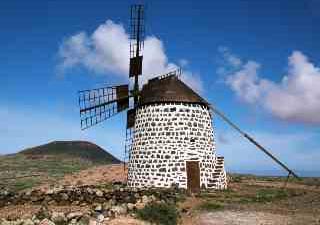 villaverde
villaverde
The small town does not really stand out with anything special, however, it is worth visiting because of two attractions: a volcanic tunnel inhabited in the past by Maj os and a beautifully restored historic country estate – farm la rosita, where a small museum was created, Botanic Garden, a farm with animals and a shop with local products and handicrafts. Hikers will also find something for themselves here -Villaverde perched at the foot of the Escanfrag crater. The approach takes approx. 30 min, and from the top there is a breathtaking view of the dunes in the vicinity of Corralejo, z Isla de los Lobos i Lanzarote na horyzoncie.
The bus stops three times a day in Villaverde #7. For a typical island meal, stay at the Hotel Rural Casa Mahoh, Rancho.
The olive
La 0liva is in the Highlands for a short time (1835-1860) was the capital of Fuerteventura. The 18th-century Iglesia de Nuestra Seńora de la Candelaria and Casa de los Coroneles, located a few hundred meters to the south, testify to the former glory of the now somewhat deserted town. (The Colonels' House). The colonial-style building once housed the island's military commanders. The building was deteriorating for a long time, however, it regained its former splendor after a thorough renovation in 2006 r., during which it was converted into exhibition halls, where contemporary art exhibitions are held from time to time. More contemporary art can be seen across the street, w Casa Mane Canarian Art Center. Sculptures and paintings were collected in the garden surrounding the museum and its interior, m.in. Cesara Manrique placeholder image. On the FV-10 road leading to El Cotillo (ok. 250 meters meters from the church) is minor, but an interesting museum – Casa Cilla Grain Museum. In a museum in a historic farm building with 1819 r. you can learn almost everything about traditional grain farming.
Buses stop several times a day in La Olivie #7 i 8.
There is a very non-touristic Suarez Bar on site (to the left of the church), where the townspeople hang out, and the Malpey restaurant, where you can try authentic island cuisine.
Tindaya
A small village lies at the foot of the sacred mountain of Majos, rising on approx. 400 m n.p.m. Tindaya Mountain.
On the steep slopes of the mountain, approx 300 petroglyphs made by the first inhabitants of the island. There is a fairly well-visible trail leading up Montana de Tindaya - a trip from the village to the top of the mountain and back is a matter of covering approx.. 3 km not very difficult, albeit a steep route in places.
The town itself does not seem very interesting – you can see a small chapel in it, Hermitage of Our Lady of Charity, from 1766 r. There are also several small bars on site. There is a bus to Tindaya three times a day #7 z Puerto del Rosario.
Miguel de Unamuno Monument
A few hundred meters south of the village of Tindaya, at the foot of the Montana Quemada crater stands a monument in memory of the writer Miguel de Unamuno, which at the beginning of the 20th century. he was exiled to Fuerteventura for criticizing the then King of Spain and its prime minister Prima de Rivera. Writer, who spent the last years of his life on the peninsula, he wanted, to be buried in Fuerteventura. Unamuno's will was not respected, however, as if in compensation, a monument was erected for him, which for many people resembles a symbolic tombstone.
Tefia
An ethnographic museum has opened in this small village – The Welcome Ecomuseum. A former farmhouse has been recreated in six renovated traditional houses, where you can learn about traditional methods of storing water and food, see farm animals and visit workshops, e.g.. wicker, ceramic etc., and also buy handicrafts and try traditional food.
There are two nice windmills in the town.
The mills
Not all 11 km west of Teffi, on the shores of the ocean there is a small settlement of Los Molinos – the perfect place for a quiet afternoon sunbathing. Several houses were built around the sandy and rocky beach, squeezed between fancifully shaped rocks, mainly inhabited by fishermen. Try some really fresh and inexpensive fish dishes at Casa Pon Restaurant. You can only get to Los Molinos by your own means of transport.
The most beautiful routes: Mills Ravine
4 km west of the village of Tefia, Barranco de los Molinos begins in the small settlement of Colonia Garda Escamez, The gorge of the windmills – one of the greenest places on the island. Even in the middle of summer, a small trickle of water flows in the middle of the ravine. Going down to the gorge in Colnia Garda Escśmez, in less than two hours you can walk to the small fishing village of Los Molinos on the coast.